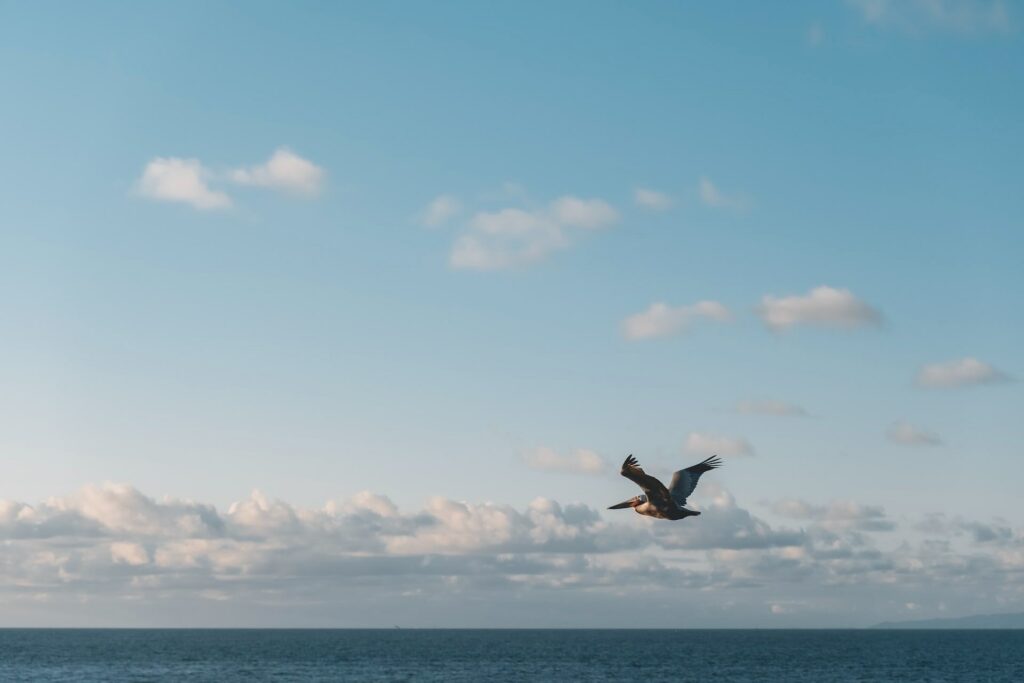この記事で紹介されました
カリフォルニア州サンディエゴ
サンディエゴ・ホエール&ドルフィンウォッチングアドベンチャー
もっと詳しく
サンディエゴのCity Cruises Whale Watchクルーズでは、素晴らしい海鳥を見ることができます。サンディエゴ湾で見られる、数種のサギを含む、あまり一般的でないその他の海鳥をご紹介します。
Reddish egret (Egretta rufescens)
The reddish egret is a fairly large heron with a gray body, a reddish neck, and bluish-black gray legs. Its bill is mostly pink and tipped with black. This active egret searches for food in shallow, saltwater habitats and often runs and hops to catch fish with its wings spread out. San Diego is near the northern part of the range for this species on the Pacific Coast.
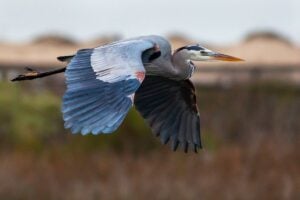
Little blue heron (Egretta caerulea)
The little blue heron is a small heron with a dark bluish-gray body and a purple to dark reddish head and neck. Juveniles are mostly white with light gray wing feathers. When hunting fishes and frogs in shallow freshwater or saltwater habitats, the little blue heron will stand still in shallow water and wait for potential prey to swim nearby.
Tri-colored heron (Egretta tricolor)
This medium-sized heron is mostly dark gray with a white belly and reddish feathers on its neck and back. The juvenile has a white line running down its throat. When foraging, it either stands and waits for fish to swim by, or walks to stir up the bottom with a foot to startle prey.
Green heron (Butorides virescens)
This small, beautifully-colored heron typically rests in a crouched position at the water’s edge often hidden within vegetation. It has a greenish back with a chestnut neck, face, and chest, white streaks on each cheek and throat, dark gray wings, a gray and yellow bill, and yellow legs. The green heron usually sits at the water’s edge and waits for fish and frogs to move by, then spears them with its dagger-like bill.
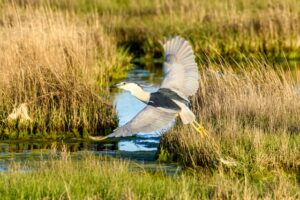
Black-crowned night heron (Nycticorax nycticorax)
The black-crowned night heron is fairly stocky with relatively short yellow legs. The plumage is dark gray from the top of its head to the back, with light-gray wing feathers, and white from the face to the belly. It also has a white patch extending from the base of the upper bill to above the red eyes. Juveniles are mottled brown and white. As its name implies, the black-crowned night heron feeds from dusk until dawn, searching for insects, worms, fishes, amphibians, and other small land and aquatic animals.
Brandt’s cormorant (Phalacrocorax penicillatus)
The Brandt’s cormorant is an iridescent black seabird found in saltwater habitats along the Pacific Coast of North America. Adults have a pale patch at the base of the throat, a bright blue throat pouch, and fine, white plume feathers on their head, neck, and back during the nesting season. During the non-breeding season, adults are much duller in color while juveniles are also a much duller brownish-black. Cormorants swim at the surface and then dive to catch fish or squid, using their webbed feet to actively swim after prey. Like other cormorants, the Brandt’s cormorant holds its wings out to dry after diving.
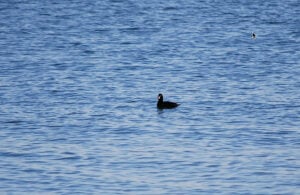
Surf scoter (Melanitta perspicillata)
This sea duck is strikingly patterned in black-and-white. The male is all black with a white forehead patch and a white patch on the back of his neck, and a white, orange, and black patterned bill. The female is a lighter brownish-black with white patches on each side of the head and at the base of the mostly dark gray bill. Nesting takes place during summer in freshwater lakes in high-elevation forests and the tundra mainly in Alaska and Canada. Surf scoters can be found in winter along both coasts of North America where it can often be seen diving for mollusks, crustaceans, and other aquatic invertebrates.
Pacific brant (Branta bernicla)
This small sea goose has a black head, neck, and chest with a broken white “collar” in the upper neck region, a brownish back, a black to light gray belly, and a white rump. The Brant nests in the Arctic on the tundra and spends winters feeding on eelgrass, sea lettuce, and other aquatic plants along both coasts of North America. The Pacific subspecies of brant winters from British Columbia to Baja California, Mexico, and can often be seen swimming and feeding in flocks during the late fall to early spring months in San Diego Bay.
Western grebe (Aechmophorus occidentalis)
The western grebe is a black and white grebe with a long neck, a spear-like yellow bill, and red eyes. This species has a black back with black extending along the back of its neck and a black cap that extends below the eyes. The almost identical Clark’s grebe can be distinguished from the western grebe by its white face (its black cap does not extend below the eyes). Western grebes nest on freshwater lakes and marshes and overwinter in bays, estuaries, and sheltered coasts. They dive to catch fish and occasionally crustaceans and aquatic worms. In the summer nesting grounds, adults perform an elaborate courtship display by rushing across the water with their necks extended.
Pied-billed grebe (Podilymbus podiceps)
The pied-billed grebe is a small, stocky, brown, bird with a short wedge-shaped bill, a brown body, and an extremely short tail. Their bill is marked with a vertical black stripe in the summer giving rise to their common name. Pied-billed grebes dive to hunt small fishes, crustaceans, insects, amphibians, and other small aquatic animals in freshwater lakes, rivers, marshes, and saltwater estuaries and bays.
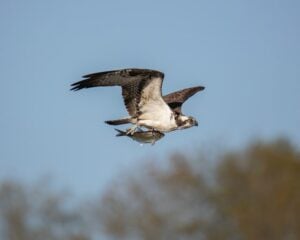
Osprey (Pandion haliaetus)
The Osprey is a common fish-eating hawk spotted in freshwater and saltwater habitats worldwide except in Antarctica. These attractive birds of prey are black to brown and white and have hooked bills and yellow eyes. They have a reversible outer toe on each foot and barbed pads on the soles that let them catch and easily grasp slippery fish. Osprey pairs build huge nests of sticks and other vegetation that are added to each nesting season and used from year to year. Often these nests are built on sea stacks, dried tree snags, and even man-made structures such as light towers, utility poles, and artificial platforms. Some of these nests are decades old and can be 10 to 13 feet tall and 3 to 6 feet across.
褐色 ペリカン
ブラウンペリカンは北米最大のペリカン。猫背で首が長く、大きな嘴と魚をすくい上げるための喉袋が特徴的な大型鳥類である。体色は濃い褐色で、翼と首は明るい灰褐色をしている。北アメリカ大陸の沿岸部に生息し、空中から水中に飛び込んで捕獲する小魚をほぼ独占的に食べている。繁殖はバージニア州からテキサス州、カリフォルニア州の海岸沿いと五大湖の内陸部で行われる。
アメリカ白ペリカン
アメリカシロペリカンは北米最大の鳥のひとつで、翼を広げると約1.5メートルにもなる。全身が白く、翼端が黒く、長い嘴と魚をすくい上げるための大きな喉袋を持つ。ペリカンは群れで泳ぎ、小魚を群れで捕らえ、捕らえやすい浅瀬で罠にかけるなど、協力的に餌を食べる。この大きな鳥は、カナダ西部とアメリカ北部の内陸の湖で繁殖し、冬はカリフォルニアからテキサスまでの海岸沿いで過ごす。
姫鵜
世界の外洋域で繁殖するウの一種。全身が黒く、鉤状の長い嘴と網目のある足が特徴。泳ぎが得意で、魚を捕らえるために水深10mまで潜ることができる。水辺の崖や木に巣を作る。社会性があり、他の鳥と大きなコロニーを形成することもある。カモメやワシなどの猛禽類がよく狙う。

ワライカワウ
長い首と鉤状の嘴を持つ大型の水鳥。北米の淡水域と海水域に生息する。泳ぎが得意で、魚やザリガニなどの水生生物を捕食する。黒い羽は捕食者からカモフラージュするのに役立ち、網目のある足は水中を素早く漕ぎ進むのに役立つ。天然記念物であり、近年、その数は増加している。しかし、電線や船などの人工物に巣を作る習性があるため、人間との衝突が起こることもある。
ロックバト(コロンバ・リビア)
岩鳩は、ヨーロッパ、アジア、アフリカに生息する鳩の一種である。都市部では最もよく見かける鳥でもある。中型の鳥で、ふっくらとした体と短い脚が特徴である。羽の色は通常グレーかブルーだが、白、茶、黒もある。頭が小さく、くちばしが尖っている。群れで生活し、都市部では餌をあさっている姿がよく見られる。また、クークーという鳴き声でも知られている。ロックバトは野生でも飼育下でも重要な種である。様々な環境に適応する能力があるため、研究にもよく利用される。また、世界各地に導入され、厄介な種として定着している。
結論
サンディエゴ湾であまり一般的でない海鳥を見たい場合は、ぜひこのリストをご覧ください。もっと多くの種がここで見られますが、この15種で何がそこにあるのかの良いサンプルが得られると思います。あなたは、湾内を旅して、これらの鳥を発見しましたか?下のコメント欄で教えてください。
この記事で紹介されました
カリフォルニア州サンディエゴ
サンディエゴ・ホエール&ドルフィンウォッチングアドベンチャー
もっと詳しく


